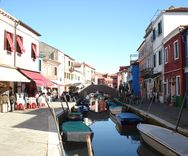
|

BURANO ISLAND
Burano is an island located in Venice Lagoon,
approximately 9 km from the City. Burano is comprised of
4 smaller islands linked by a long bridge to the island of Mazzorbo
and has a population of about 2800 inhabitants. The main activities
on Burano island are: fishing, dock
yarding (making boats) and the production of
lace. During the last few decades the main resource in Burano island has
been tourism. Tradition says that the name of Burano
comes by the gate B˛rea located in Altino: it seems in fact that the
first inhabitants of Burano island, escaping from the barbarian hordes,
had latin-altinate origins. The first name of Burano island was Vicum
Burianum.
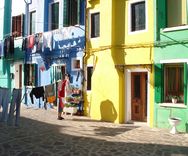
It's possible to get to
Burano island by both private or public means of transportation.
Among the private companies offering excursions to Burano island are:
Venezia
Noleggi Imbarcazioni, Veniceboat. The public
company Actv offers a regular waterbus service (vaporetti,
line 12), with departures to Burano island from stop "Fondamente
Nove" every 30 minutes during the day. Along the route you
can see on the right the cemetery (San Michele), then on
the left, Murano island (there is a stop near the
lighthouse as well). Entering the "Canal dei Marani" you get in the
open lagoon, on the right you can see the Arsenal and
Certosa, then the islands of Vignole and Sant'Erasmo, real
truck-farms of the City (whose agricultural products arrive daily to
the Rialto market). Then you pass near to the islands of San Giacomo in Paludo
and the Madonna del Monte. The latter is really ruined. You get to
Mazzorbo, the ancient Maiurbum, long time ago a
place of residence for noble Venetians, is now full of truck-farms
and vineyards. At the end of the "Canale di Mazzorbo" you can see on
the right the small Santa Caterina Church, built in the fourteenth
century. Then on the left there is the ancient
Torcello island. Finally you at in the unique stop
of Burano island, close to the public park with benches; a perfect place for a
picnic.
Tradition says that the island has a colorful look
for this reason: during winter time Burano island has many
foggy days and when the fishermen come back after fishing they can
easily recognize their own home. As a result Burano island's
inhabitants paint the exteriors of
the houses in olive-green, lilac, blue, yellow and so
on. The unique milieu of Burano island attracted many
landscape-painters during the first years of the twentieth century.
The "School of Burano" was born between 1911 and
1946. It is not a real school but an important season for the
contemporary Venice painting. We can list some of the artists that
lived in Burano island: Gino Rossi, Arturo Martini, Novello,
Martini. Burano island surely deserves a visit even if your stay in
Venice will be a short one. On Burano island there is a special
atmosphere, probably the same that there was in the "Serenissima" during its
ancient age. After 7pm, when the last tourists leave Burano island you
can feel you are in a place without time.
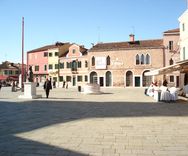
The art of lace has ancient origins in Burano. The production started
in the fifteenth century, supported by the doge's wife Morosina
Morosini first and by Giovanna Duodo wife of the doge Pasquale
Malipiero, later. The "punto (stitch) Burano" or "punto in
aria" (so called as the lace is
not layed on the loom) became an appreciated and required technique
in all of Europe. The French competition started in the second
half of the eighteenth century as Colbert, the prime minister of
King Luis XIV, through money and allurements, found the way to bring
to his court many lace-makers from Burano island. The Venice government
tried to stop this escape with strict laws but it was too late;
lace's crisis was started. Having added insult to injury, in Burano island
some lace-makers started using the "point de France". This situation
continued until the end of the nineteenth century, when the countess
Adriana Marcello and the old master Cencia Scarpariola,
(at that age eighty years old and almost blind) saved the secular
tradition, handing down the "punto Burano" to posterity. Then was
found a school in Burano island, supported by the Queen of
Italy, Margherita di Savoia.
The main street in
Burano island is called Via Galuppi. Here there are many
shops selling souvenirs, and bakeries that show the island's traditional
cake, the "BussolÓ", a circle made by a sweet and
hard dough with eggs, whose diameter is about 10 centimeters. Another variant of "BussolÓ" is the "Esse",
with its typical "S" shape, but having the same taste. Every week, in
Rio TerÓ del Pizzo, is remarkable the Burano island's market, where it is possible
to buy various foods and more.
Daily, in Campo della Pescheria,
you'll find the fish market that always offers
fresh fish, and a small market which sells fruit and vegetables
coming from the lagoon's islands. In Burano island there are some
restaurants that offer fresh fish, often daily caught. Here is a
list of the most celebrated: "Da Romano
", Via Galuppi 221, tel. +39 041 730030, that
have had among its clients many important personages. Other restaurants in Burano
"Trattoria al Gatto
Nero " - Via Giudecca 88, tel. +39 041 730120.
"Trattoria al Raspo de Ua
" - Via Galuppi 560, telephone +39 041 730095.
"Ristorante dal Baffo" - Via Galuppi 359, tel. +39 041 730108.
"Ristorante Galuppi" - Via Galuppi 468, telephone +39 041 730081.
"Ristorante da Forner
" - Fondamenta Terranova, tel. +39 041 730002.
"Ristorante al Vecio Pipa" - Strada San Mauro 395, telephone +39 041 730045.
"Ristorante ai Pescatori" - Via Galuppi 371, tel. +39 041 730650.
"Ristorante Amadi" - Piazza Galuppi 227, telephone +39 041 730092.
"Trattoria Maddalena" - Fondamenta Santa Caterina 7 (Mazzorbo), tel. +39 041 730151.
"Ristorante Riva Rosa" - Burano, San Mauro 296, tel. +39 041 730850.
"Ristorante Pizzeria Principe" - Burano, S. Mauro 455, tlf. +39 041 735067.
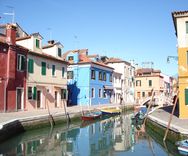
In Burano island is very diffuse the "voga
alla veneta" (a rowing style but standing). During ancient
times it was necessary to carry the fish to the City or to the
mainland, but today it is almost only a sport. Very famous is the
Burano regatta, a competition for 2-oar
gondolas, that runs every year on the third Sunday of September and
represents the rematch of "Regata Storica", run only two weeks
before. In Burano island were born many "Champions of the Oar",
the most famous was Sergio Tagliapietra nicknamed
"Ciaci" (Burano 1935). He
won 14 editions of "Regata Storica" (rowing "gondolino"), 21 Burano
regattas and 18 Murano regattas (1-oar gondolas). "Ciaci" is a real
myth for Venetians as he won more than 200 red flags (the prize for
the winner; the second gets the white flag, the third the green
flag, the fourth the blue flag). Sergio Tagliapietra played in the
Olympic Games in Melbourne and Tokyo and finally won 13 editions of
"Palio delle Repubbliche Marinare" (a competition run by Venice,
Amalfi, Pisa and Genoa). The traditional way to row by the local
fishermen is "alla valesana" or "alla buranella" (the boatman rows
alone standing with two crossed oars). In Burano is active the
Associazione Remiera Vogaepara that offers rowing courses. It's
located in Burano island, Strada San Mauro 58, tel. +39 041 735018.
It's not possible to talk about Burano island without
mentioning the name and the life of its most celebrated son:
Baldassarre Galuppi (Burano 1706 -
Venice 1785), nicknamed "the Buranello". He was a composer and a
theatrical author and his operas were played in London (1741-46).
Then he was appointed by the Russian Czarina Caterina as a court
composer (1765-68). He cooperated with Carlo Goldoni in writing some
comedies. He composed more than 100 operas (specializing in the
"opera buffa"), sacred and instrumental music.
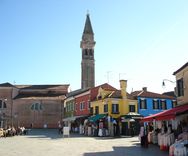
At the end of Via Galuppi
you get to the square bearing the same name, having in the center
the monument of the musician. On the left there is the "Palazzo
Comunale" built in gothic style that has inside the Burano
Museum (opened in 1981), and the Burano Lace
School (founded by the countess Adriana Marcello). This
Museum (Museo Civico del Merletto), tel. +39 041 730034, shows
beautiful examples of Venice production from the sixteenth to the
twentieth century. On the right of
the square is San Martino's Church (Saint Martin, the Bishop
of Tours - France, is the protector of Burano as well). The church was
built during the fifteenth century. Inside is "the Crucifixion" a
Giambattista Tiepolo's painting. The leaning bell tower is already
part of the lagoon landscape.
Beyond San Martino's
Church are located some small shops selling souvenirs then a kiosk (if
you need a toilet, drink something and kindly ask for the key of the
toilet located at rear). Finally you get to the public park. From
this place there are many beautiful views. Towards south, not too
far away from Burano island, you can see the Island of San Francesco del
Deserto. This monastery lies in a far corner of the lagoon and
it was called "of the two vineyards". An ancient story says that in
1220, during a storm,
Saint Francis of Assisi along with friar
Illuminato da Rieti, coming back from their pilgrimage to Holy
Land landed here. On that place Saint Francis built a hut to
stay. Then the saint, Italy's patron, planted its walking-stick that
germinated, as a result is possible to see the rest of a secular
pine inside of the Franciscans' convent. The Order received the
island in 1233 as a gift from the noble Venetian Jacopo Michiel. The
austere small church located inside of the convent was built in the
thirteenth century. It's only possible to visit San Francesco del
Deserto with private transportation as it is not available a public line of
transportation linking Burano island to S. Francesco del Deserto.
Budget hotel in Venice
|